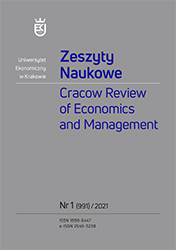The Prospects for Poland Joining the Euro Area in the Context of the Theory of Optimal Currency Areas and Convergence Criteria
DOI:
https://doi.org/10.15678/ZNUEK.2021.0991.0107Keywords:
the euro area, theory of optimal currency areas, the convergence criteria, monetary integrationAbstract
Objective: The aim of the study is to determine the benefits and threats of introducing the euro in Poland in the context of the theory of optimal currency areas and convergence criteria.
Research Design & Methods: A critical analysis of the literature on the subject, both Polish and foreign, as well as statistical analysis based on data from the World Bank, The European Commission, the Polish Central Statistical Office, the Eurostat and TradingEconomics.com were used.
Findings: Currently, the euro area does not meet the theory OCA assumptions, and Poland does not meet the convergence criteria. Therefore, Poland cannot join the euro area. Moreover, joining the European Monetary Union may open the door to more threats than benefits.
Implications / Recommendations: Poland, as a country with a derogation, is obliged to meet the convergence criteria and join the euro area, but it is not ready at present. However, Poland and the euro area together could eventually create an optimal currency area.
Contribution: The results contribute to the debate on European monetary integration and the prospects for the introduction of the euro in Poland and may constitute a basis for further research.
Downloads
References
Benczes I. (2014), The Theory of Optimum Currency Areas (w:) Economics of Global and Regional Integration, red. T. Palánkai, Akadémiai Kiadó, Budapest.
Buigut S. (2010), Loss of Monetary Policy Autonomy and Public Attitude toward Monetary Union, ,,Journal of International and Global Economic Studies”, nr 2(2).
Convergence Report 2020 (2020), Institutional Paper, nr 129, European Commission, Brussels.
Cymbranowicz K. (2018), Refleksja na temat członkostwa Polski w strefie euro z perspektywy rynku pracy, ,,Zeszyty Naukowe Uczelni Vistula”, nr 62(5).
De Grauwe P. (2012), The Political Economy of the Euro, ,,Annual Review of Political Science”, vol. 16, nr 1. DOI: https://doi.org/10.1146/annurev-polisci-060911-085923
Eichengreen B. (1992), Should the Maastricht Treaty Be Saved?, Princeton University, Princeton.
European Economic Forecast. Autumn 2020 (2020), Institutional Paper, nr 136, European Commission, Luxembourg.
Introduction of the Euro in the Member States That Have Not Yet Adopted the Common Currency (2020), Flash Eurobarometer 487, European Commission, https://op.europa.eu/pl/publication-detail/-/publication/a2b06439-d855-11ea-adf7-01aa75ed71a1 (data dostępu: 25.02.2021).
Kawalec M. (2018), Elastyczność rynku pracy w Polsce w świetle teorii optymalnych obszarów walutowych, ,,Zeszyty Naukowe Uniwersytetu Ekonomicznego w Krakowie”, nr 5(977), https://doi.org/10.15678/ZNUEK.2018.0977.0509. DOI: https://doi.org/10.15678/ZNUEK.2018.0977.0509
Kenen P. (1969), The Theory of Optimum Currency Areas: An Eclectic View (w:) Monetary Problems of the International Economy, red. R. Mundell, A. Swoboda, The University of Chicago Press, Chicago.
Kunroo M.H. (2015), Theory of Optimum Currency Areas: A Literature Survey, ,,Review of Market Integration” vol. 7, nr 2, https://doi.org/10.1177/0974929216631381. DOI: https://doi.org/10.1177/0974929216631381
McKinnon R. (1963), Optimum Currency Area, ,,American Economic Review”, vol. 53, nr 4.
Mongelli F.P. (2002), “New” Views on the Optimum Currency Area Theory: What Is EMU Telling US?, European Central Bank, Working Paper, nr 138. DOI: https://doi.org/10.2139/ssrn.357400
Mundell R. (1961), A Theory of Optimum Currency Areas, ,,The American Economic Review", vol. 51, nr 4.
Mundell R. (1973), A Plan for a European Currency (w:) The Economics of Common Currencies, red. H.G. Johnson, A.K. Swoboda, Allen and Unwin, Crows Nest.
Paleta T. (2012), Maastricht Criteria of… Divergence?, ,,Review of Economic Perspectives – Národohospodářský Obzor”, vol. 12, nr 2, https://doi.org/10.2478/v10135-012-0005-7. DOI: https://doi.org/10.2478/v10135-012-0005-7
Piwnicki G. (2016), Dylematy wprowadzenia euro w Polsce przez pryzmat polityczny i gospodarczy, ,,Przegląd Politologiczny”, nr 1, https://doi.org/10.14746/pp.2016.21.1.7. DOI: https://doi.org/10.14746/pp.2016.21.1.7
Pukin P. (2019), Wpływ wprowadzenia euro na handel państw członkowskich unii monetarnej, ,,Catallaxy”, vol. 4, nr 2, https://doi.org/10.24136/cxy.2019.007. DOI: https://doi.org/10.24136/cxy.2019.007
Pukin P., Włodarczyk B. (2021), Sub-Zones in The Euro Area as Optimum Currency Areas (w:) Proceedings of the 36th International Business Information Management Association Conference (IBIMA), red. K.S. Solima, International Business Information Management Association, Granada.
Ricci L.A. (1997), A Model of an Optimum Currency Area, ,,IMF Working Papers”, nr 76. DOI: https://doi.org/10.5089/9781451849837.001
Sawyer M. (2006), The Economic and Monetary Union: Past and Present Failures and Some Future Possibilities, ,,World Economic Review”, vol. 6.
Schmidt C., Straubhaar T. (1995), Maastricht II: Are Real Convergence Criteria Needed?, ,,Intereconomics, nr 30(5), https://doi.org/10.1007/BF02926364. DOI: https://doi.org/10.1007/BF02926364
Stanković M. (2013), The Advantages of Being a Member of the European Monetary Union and Its Influence on Trade in the Eurozone, ,,Škola biznisa”, nr 2, https://doi.org/10.5937/skolbiz1302030S. DOI: https://doi.org/10.5937/skolbiz1302030S
Toader V., Gîdiu V. (2012), The Study of Nominal Convergence in European Union, ,,Procedia Economics and Finance”, nr 3, https://doi.org/10.1016/s2212-5671(12)00243-2. DOI: https://doi.org/10.1016/S2212-5671(12)00243-2
Wierzejski T., Siemionek M. (2012), Convergence Problems in the Eurozone, ,,Olsztyn Economic Journal”, vol. 7, nr 2, https://doi.org/10.31648/oej.3431. DOI: https://doi.org/10.31648/oej.3431
Włodarczyk B. (2016), Makroekonomiczne skutki wprowadzenia waluty euro w krajach członkowskich Unii Europejskiej, ,,Annales Universitatis Mariae Curie-Skłodowska”, vol. 50, nr 4, https://doi.org/10.17951/h.2016.50.4.559. DOI: https://doi.org/10.17951/h.2016.50.4.559
Zbierzchowska D. (2010), Konsekwencje stosowania określonych systemów kursowych w warunkach kryzysu finansowego na przykładzie krajów Europy Środkowo-Wschodniej, ,,Equilibrium”, vol. 1, nr 4.
Downloads
Published
Issue
Section
License
Copyright (c) 2021 Zeszyty Naukowe Uniwersytetu Ekonomicznego w Krakowie / Cracow Review of Economics and Management

This work is licensed under a Creative Commons Attribution 4.0 International License.

